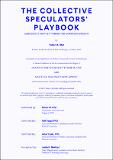| dc.contributor.advisor | Segal, Rafi | |
| dc.contributor.advisor | Saiz, Albert | |
| dc.contributor.author | Ofer, Tamar M. | |
| dc.date.accessioned | 2023-11-02T20:10:54Z | |
| dc.date.available | 2023-11-02T20:10:54Z | |
| dc.date.issued | 2023-09 | |
| dc.date.submitted | 2023-09-18T13:04:15.145Z | |
| dc.identifier.uri | https://hdl.handle.net/1721.1/152720 | |
| dc.description.abstract | In 2016, a remarkable collaboration between the State of New York and the city’s largest landlord redirected a staggering $1.6 billion from neighborhoods hosting the highest unemployment rates along the Harlem River to Midtown's Hudson Yards, marking the costliest privatized development in American history. Through a dizzying array of financial tactics, regulatory loopholes, and spatial manipulations to fund this unprecedented development, the axis stretched between Hudson Yards and Harlem River Yards exposes a dominant state-sponsored speculative urban development model in urban New York - often operating above the designer’s head.
This thesis draws the practices, policies, and protocols of the speculative urban development model across two urban projects. It identifies two key actors: the developer, who speculates on financial returns, the designer, who speculates on spatial forms. The gap between them can then be termed the ‘speculative spectrum’. In it, the developer, adept at capturing value but often lacking socio-spatial literacy to create them in situ, contrasts with the designer, proficient in creating values but lacking the mechanisms to capture them. This dichotomy draws the required leverage points to intervene in an existing system design that underpins prevalent forms of urban speculation, paving the way for a local cross-sector partnership in the Mott Haven-Port Morris neighborhood of Harlem River Yards.
In collaboration with a civic coalition, uncovered and invented speculations are mobilized and reconfigured to assemble a collective ‘playbook’ for co-disciplinary forms of urban speculation. It compiles a repository of ‘plays’ into a design portfolio of spatial, economic, and political plays that re-imagine Harlem River Yards as a collective waterfront rather than an industrial wasteland. In doing so, it posits that design must not only actively reengage with current forms of real estate speculation but must strategically reposition its practices as a design project in and of itself. | |
| dc.publisher | Massachusetts Institute of Technology | |
| dc.rights | In Copyright - Educational Use Permitted | |
| dc.rights | Copyright retained by author(s) | |
| dc.rights.uri | https://rightsstatements.org/page/InC-EDU/1.0/ | |
| dc.title | The Collective Speculators’ Playbook Subversive Market Forms for Common Wealth | |
| dc.type | Thesis | |
| dc.description.degree | S.M. | |
| dc.description.degree | S.M. | |
| dc.contributor.department | Massachusetts Institute of Technology. Center for Real Estate. Program in Real Estate Development. | |
| dc.contributor.department | Massachusetts Institute of Technology. Department of Architecture | |
| mit.thesis.degree | Master | |
| thesis.degree.name | Master of Science in Architecture Studies | |
| thesis.degree.name | Master of Science in Real Estate Development | |
